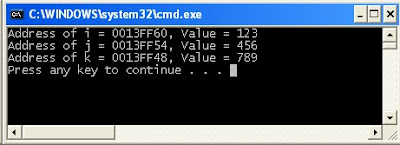//Program tested on Microsoft Visual Studio 2010 - Zahid Ghadialy //Example demonstrates creating an XML file //Based on example at: http://www.codeproject.com/Articles/32762/Xerces-for-C-Using-Visual-C-Part-2 //Xerces is xerces-c-3.1.1-x86-windows-vc-10.0 #include <iostream> #include <string> #include <sstream> //Mandatory for using any feature of Xerces. #include <xercesc/util/PlatformUtils.hpp> //Use the Document Object Model (DOM) API #include <xercesc/dom/DOM.hpp> //Required for outputing a Xerces DOMDocument to a standard output stream (Also see: XMLFormatTarget) #include <xercesc/framework/StdOutFormatTarget.hpp> //Required for outputing a Xerces DOMDocument to the file system (Also see: XMLFormatTarget) #include <xercesc/framework/LocalFileFormatTarget.hpp> using namespace std; XERCES_CPP_NAMESPACE_USE void DoOutput2Stream(DOMDocument* pmyDOMDocument); void DoOutput2File(DOMDocument* pmyDOMDocument, const wchar_t * FullFilePath ); int main() { // Initilize Xerces. XMLPlatformUtils::Initialize(); // Pointer to our DOMImplementation. DOMImplementation* p_DOMImplementation = NULL; p_DOMImplementation = DOMImplementationRegistry::getDOMImplementation(XMLString::transcode("core")); // Pointer to our DOMDocument. DOMDocument* p_DOMDocument = NULL; p_DOMDocument = p_DOMImplementation->createDocument(0, L"Hello_World", 0); DOMElement * p_RootElement = NULL; p_RootElement = p_DOMDocument->getDocumentElement(); //Fill in the DOM document - different parts //Create a Comment node, and then append this to the root element. DOMComment * p_DOMComment = NULL; p_DOMComment = p_DOMDocument->createComment(L"Dates are formatted mm/dd/yy." L" Don't forget XML is case-sensitive."); p_RootElement->appendChild(p_DOMComment); //Create an Element node, then fill in some attributes, and then append this to the root element. DOMElement * p_DataElement = NULL; p_DataElement = p_DOMDocument->createElement(L"data"); //Copy the current system date to a buffer, then set/create the attribute. wchar_t wcharBuffer[128]; _wstrdate_s(wcharBuffer, 9); p_DataElement->setAttribute(L"date", wcharBuffer); //Convert an integer to a string, then set/create the attribute. _itow_s(65536, wcharBuffer, 128, 10); p_DataElement->setAttribute(L"integer", wcharBuffer); //Convert a floating-point number to a wstring, then set/create the attribute. std::wstringstream myStream; myStream.precision(8); myStream.setf(std::ios_base::fixed, std::ios_base::floatfield); myStream << 3.1415926535897932384626433832795; const std::wstring ws(myStream.str()); p_DataElement->setAttribute(L"float", ws.c_str()); p_RootElement->appendChild(p_DataElement); // Create an Element node, then fill in some attributes, add some text, // then append this to the 'pDataElement' element. DOMElement * p_Row = NULL; p_Row = p_DOMDocument->createElement(L"row"); // Create some sample data. _itow_s(1, wcharBuffer, 128, 10); p_Row->setAttribute(L"index", wcharBuffer); /* Create a text node and append this as well. Some people prefer to place their data in the text node which is perfectly valid, others prefer to use the attributes. A combination of the two is quite common. */ DOMText* p_TextNode = NULL; p_TextNode = p_DOMDocument->createTextNode(L"Comments and" L" data can also go in text nodes."); p_Row->appendChild(p_TextNode); p_DataElement->appendChild(p_Row); // Create another row (this time putting data and descriptions into different places). p_Row = p_DOMDocument->createElement(L"row"); p_Row->setAttribute(L"description", L"The value of PI"); p_TextNode = p_DOMDocument->createTextNode(L"3.1415926535897932384626433832795"); p_Row->appendChild(p_TextNode); p_DataElement->appendChild(p_Row); // Create another row. p_Row = p_DOMDocument->createElement(L"row"); p_Row->setAttribute(L"website", L"http://www.3g4g.co.uk/"); p_TextNode = p_DOMDocument->createTextNode(L"3G and 4G Wireless Resources"); p_Row->appendChild(p_TextNode); p_DataElement->appendChild(p_Row); //Output on console DoOutput2Stream(p_DOMDocument); //Output to a file DoOutput2File(p_DOMDocument, XMLString::transcode("..\\..\\XML\\Test.xml")); // Cleanup. p_DOMDocument->release(); XMLPlatformUtils::Terminate(); return 0; } void DoOutput2Stream(DOMDocument* pmyDOMDocument) { DOMImplementation *pImplement = NULL; DOMLSSerializer *pSerializer = NULL; XMLFormatTarget *pTarget = NULL; /* Return the first registered implementation that has the desired features. In this case, we are after a DOM implementation that has the LS feature... or Load/Save. */ pImplement = DOMImplementationRegistry::getDOMImplementation(L"LS"); /* From the DOMImplementation, create a DOMWriter. DOMWriters are used to serialize a DOM tree [back] into an XML document. */ pSerializer = ((DOMImplementationLS*)pImplement)->createLSSerializer(); /* This line is optional. It just sets a feature of the Serializer to make the output more human-readable by inserting line-feeds and tabs, without actually inserting any new nodes into the DOM tree. (There are many different features to set.) Comment it out and see the difference. */ //The end-of-line sequence of characters to be used in the XML being written out. pSerializer->setNewLine(XMLString::transcode("\n")); DOMConfiguration* pDomConfiguration = pSerializer->getDomConfig(); pDomConfiguration->setParameter(XMLUni::fgDOMWRTFormatPrettyPrint, true); /* Choose a location for the serialized output. The 3 options are: 1) StdOutFormatTarget (std output stream - good for debugging) 2) MemBufFormatTarget (to Memory) 3) LocalFileFormatTarget (save to file) (Note: You'll need a different header file for each one) */ pTarget = new StdOutFormatTarget(); DOMLSOutput* pDomLsOutput = ((DOMImplementationLS*)pImplement)->createLSOutput(); pDomLsOutput->setByteStream(pTarget); // Write the serialized output to the target. pSerializer->write(pmyDOMDocument, pDomLsOutput); } void DoOutput2File(DOMDocument* pmyDOMDocument, const wchar_t * FullFilePath ) { DOMImplementation *pImplement = NULL; DOMLSSerializer *pSerializer = NULL; XMLFormatTarget *pTarget = NULL; /* Return the first registered implementation that has the desired features. In this case, we are after a DOM implementation that has the LS feature... or Load/Save. */ pImplement = DOMImplementationRegistry::getDOMImplementation(L"LS"); /* From the DOMImplementation, create a DOMWriter. DOMWriters are used to serialize a DOM tree [back] into an XML document. */ pSerializer = ((DOMImplementationLS*)pImplement)->createLSSerializer(); /* This line is optional. It just sets a feature of the Serializer to make the output more human-readable by inserting line-feeds, without actually inserting any new elements/nodes into the DOM tree. (There are many different features to set.) Comment it out and see the difference. */ DOMConfiguration* pDomConfiguration = pSerializer->getDomConfig(); pDomConfiguration->setParameter(XMLUni::fgDOMWRTFormatPrettyPrint, true); /* Choose a location for the serialized output. The 3 options are: 1) StdOutFormatTarget (std output stream - good for debugging) 2) MemBufFormatTarget (to Memory) 3) LocalFileFormatTarget (save to file) (Note: You'll need a different header file for each one) Don't forget to escape file-paths with a backslash character, or just specify a file to be saved in the exe directory. eg. c:\\example\\subfolder\\pfile.xml */ pTarget = new LocalFileFormatTarget(FullFilePath); // Write the serialized output to the target. DOMLSOutput* pDomLsOutput = ((DOMImplementationLS*)pImplement)->createLSOutput(); pDomLsOutput->setByteStream(pTarget); pSerializer->write(pmyDOMDocument, pDomLsOutput); }
The output is as follows:
The XML file is as follows:







